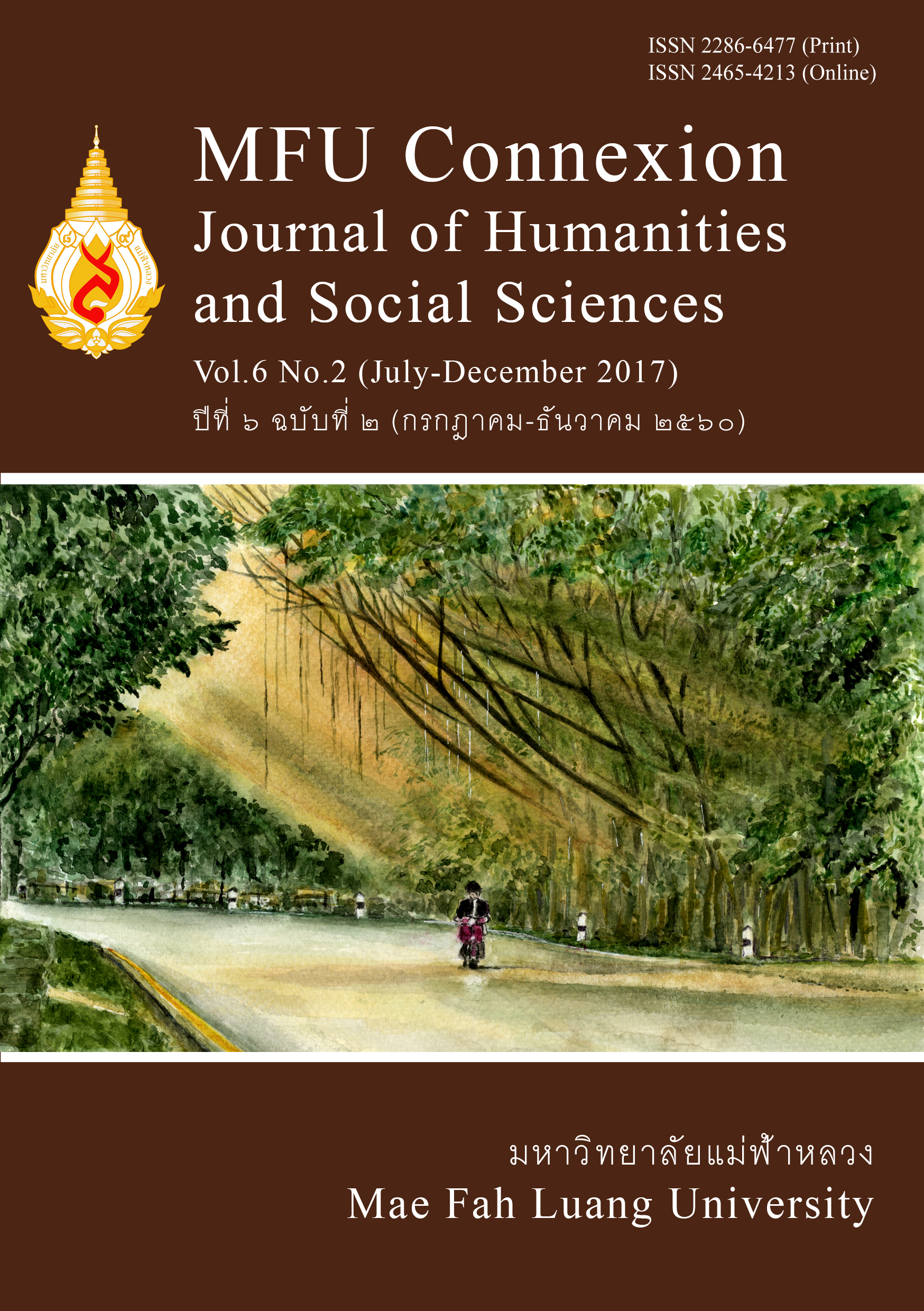The Impact of Country Personality Dimensions on Country Attractiveness and Word-of-Mouth: A Cambodian Tourism Case
Main Article Content
Abstract
Conceptualizing a country as a brand, which requires a marketing promotion, can lead to the idea of relating personality to a country. The current study thus focuses on the dimensions of country personality traits on country attractiveness and word-of-mouth in terms of tourism. A survey was conducted with a sample of Thai undergraduate students and Cambodia as the country context. Data were analyzed by a multiple regression in order to explore the relationship among country personality traits, country attractiveness and word-of-mouth. Results reveal that only the competence and sophistication country personality dimensions significantly impact country attractiveness and word-of-mouth. Furthermore, country attractiveness also partially mediates the influence of the sophistication dimension and fully mediates the influence of the competence dimension on word-of-mouth. These findings provide stakeholders in tourism business, both in public and private sectors, a better understanding of country personality so that they can create a marketing campaign for a country by positioning an appropriate country personality.
Article Details
Copyright
Connexion: Journal of Humanities and Social Sciences has an exclusive right to publish the accepted articles in any form. However, the author retains the following rights:
1. The right to the ownership of the article;
2. The right to use all or part of the article in his/her other works;
3. The right to re-produce the article for personal use or for use in the author’s organisation, in which case the author must obtain permission from Connexion: Journal of Humanities and Social Sciences;
4. The right to make copies of all or part of the work for educational use or for the author’s use in classroom teaching; and
5. The right to include the work (both the preprinted and printed versions) in an institutional repository.
References
Aaker, J. L. (1997) Dimension of brand personality, Journal of Marketing Research, vol. 34, no. 3, pp. 347-356.
Allsop, D. T., et al. (2007) Word-of-mouth research: Principles and applications, Journal of Advertising Research, vol. 47, no. 4, pp. 398-411.
Ang, S. H. & Lim, E. A. C. (2006) The influence of metaphors and product type on brand personality perceptions and attitudes, Journal of Advertising, vol. 35, no. 2, pp. 39-53.
Azoulay, A. & Kapferer, J.-N. (2003) Dobrand personality scales really measure brandpersonality?, Brand Management, vol. 11, no. 2, pp. 143-155.
d'Astous, A. & Boujbel, L. (2007) Positioning countries on personality dimension: Scale development and implications for country marketing, Journal of Business Research, vol. 60, pp. 231-239.
Baron, R. & Kenny, D. (1986) The moderator-mediator variable distinction in social psychological research: Conceptual, strategic, and statistical considerations, Journal of Personality and Social Psychology, vol. 51, no. 6, pp. 1173-1182.
Brislin, R. W. (1980) ‘Translation and content analysis of oral and written material’, in Triandis, H. C. & Berry, J. W. (Eds.), Handbook of cross-cultural psychology, vol. 2, pp. 389-444.
Etzel, M. J., et al. (2007) Marketing, New York: McGraw-Hill/Irwin.
Gallarza, M. G. & Saura, I. G. (2006) Value dimensions, perceived value, satisfaction and loyalty: An investigation of university students’ travelbehavior, Tourism Management, vol. 27, pp. 437-452.
Gonzalez-Benito, O., et al. (2008) Latent segmentation using store-level scannerdata, Journal of Product & Brand Management, vol. 17, no. 1, pp. 37-47.
Hayes, J. B., et al. (2006) Looks matter in developing consumer-brand relationships, Journal of Product and Brand Management, vol. 15, no. 5, pp. 306-315.
Kim, C. K., et al. (2001) The effect of brand personality and brand identification on brand loyalty: Applying the theory of social identification, Japanese Psychological Research, vol. 43, no. 4, pp. 195-206.
Knutson, B. J. (2000) College students & fast food: How student perceive restaurant brands, Cornell Hotel and Restaurant Administration Quarterly, vol. 41, no. 3, pp. 68-47.
Mazzarol, T., et al. (2007) Conceptualizing word-of-mouth activity, Triggers and conditions: An exploratory study, European Journal of Marketing, vol. 41, no. 11/12, pp. 1475-1494.
Mohammad, T., et al. (2005) Multicultural student perceptions of fast food restaurant brands: An Australian study, Journal of Hospitality & Leisure Marketing, vol. 12, no. 4, pp. 93-117.
Monga, A. B. & Lau-Gesk, L. (2007) Blending cobrand personalities: An examination of the complex self, Journal of Marketing Research, vol. 44, no. 3, pp. 389-400.
Neter, J., et al. (1985) Applied linear statistical models: Regression, analysis of variance, and experimental designs, Homewood, IL: Richard D: Irwin.
Nunnally, J. C. (1970) Introduction to psychological measurement, New York: McGraw- Hill.
Polyorat, K., et al. (2008) ‘Dimensions of brand personality in Thailand: Some empirical evidence’, in Taylor, C. R., Schmitt, B., Wagner, U. & Jia, J. (Eds.), Proceedings of global marketing conference, pp. 1-13, Korean: Korean Academy of Marketing Science,
Polyorat, K. & Sripongpun, K. (2015) South Korea’s country personality in Thai consumer’s perception: A qualitative study, The Journal of Business and Retail Management Research, vol. 10, no. 1, pp. 71-76.
Ray, M. L. (1973) ‘Communication and the hierarchy of effects’, in Clarke, P. (Ed.), New models for mass communication research, pp. 147-175, Beverly Hills, CA: Sage Publication.
Rojas-Mendez, J. I., et al. (2004) The ford brand personality in Chile, Corporate Reputation Review, vol. 7, no. 3, pp. 232-251.
Sweeny, J., et al. (1999) The role of perceived risk in the quality value relationship: A study in a retail environment, Journal of Retailing, vol. 75, no. 1, pp. 77-105.
Villanueva, J., et al. (2008) The impact of marketing-induced versus word-of-mouth acquisition on customer equity growth, Journal of Marketing Research, vol. 45, no. 1, pp. 48-59.
Weigold, M. F., et al. (1992) Direct response advertising: The contributions of price, information, artwork, and individual differences to purchase consideration, Journal of Direct Marketing, vol. 6, no. 2, pp. 32-39.
Wells, W. D. (1993) Discovery-oriented consumer research, Journal of Consumer Research, vol. 19, pp. 489-504.
Witkowski, T. H., et al. (2003) Cross-cultural influences on brand identity impressions: KFC in China and the United States, Asia Pacific Journal of Marketing and Logistics, vol. 15, no. 1/2, pp. 74-88.


